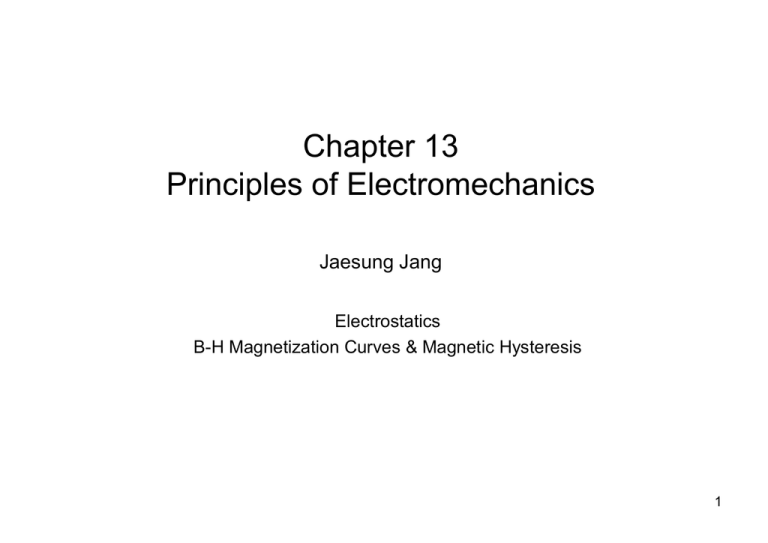Chap. 13
advertisement

Chapter 13 Principles of Electromechanics Jaesung Jang Electrostatics B-H Magnetization Curves & Magnetic Hysteresis 1 Electrostatics & Magnetic Flux The force on a stationary charge q in an electric field E F = qE The force on a charge q moving at velocity u under magnetic field with flud density B : F = q(u × B ) V = E d where E is uniformly distributed between two parallel plates, d is the distance between two conducting plates, and V is the potential difference between two conducting plates. V ++++ E d ____ Magnetic Flux Φ is defined as the number of lines of force flowing outward from a magnet’s north pole. Units: weber (Wb); One weber (Wb) = 1 x 108 lines Magnetic Flux Density B is the number of lines per unit area of a section perpendicular to the direction of flux.: B = Φ / A (=area) Units: Tesla (T) = 1 Wb/meter2 2 Types of Magnets • The basis of magnetic effects is the magnetic field associated with electric charges in motion. • Magnetic permeability is the ability to be magnetized, and it is the ability of a material to support magnetic flux. – Relative permeability (µr) compares a material with air. µr= µ (material) / µ (air) • Classification of Magnetic and Nonmagnetic Materials – Magnetic materials: • • • Ferromagnetic materials include iron, steel, nickel, cobalt, and certain alloys (usually conductors). They can become strongly magnetized in the same direction as the external magnetizing field, with high values of permeability. Paramagnetic materials include aluminum, platinum, manganese, and chromium. They become weakly magnetized in the same direction as the external magnetizing field. The permeability is slightly more than 1. Diamagnetic materials include copper, zinc, mercury, gold, silver, and others. They become weakly magnetized in the opposite direction from the external magnetizing field. The permeability is slightly less than 1. – Nonmagnetic materials: • air, paper, wood, and plastics – Ferrites are nonmetallic materials that have the ferromagnetic properties (high permeability) of iron. Common applications include ferrite cores in the coils for RF transformers, and ferrite beads, which concentrate the magnetic field of the wire on which they are strung. 3 Field Intensity (H) • Materials with high permeability can produce large values of flux density B inside the materials for an externally applied magnetic field H. Permeability drops drastically at saturation. +B • The amount of flux produced by H depends on the material in the field. • These factors are reflected in this formula: – B = µ H = µo µr H – The unit is teslas per ampere-turn per meter: T/((A · t)/m) Slope of B/H is large -H Saturation + Bmax +H Slope of B/H is small • The B-H magnetization curve shows how - Bmax much flux density B results from increasing -B field intensity H. • Saturation is the effect of little change in Slope = Permeability flux density when the field intensity increases. 4 Magnetic Hysteresis • Hysteresis refers to a situation where the magnetic flux lags the increases or decreases in magnetizing force. • Hysteresis loss is energy wasted in the form of heat when alternating current reverses rapidly and molecular dipoles lag the magnetizing force. – For steel and other hard magnetic materials, hysteresis losses are much higher than in soft magnetic materials like iron. • Hysteresis Loop – BR is called remanent (residual) magnetization, which is the flux density remaining after the magnetizing force is reduced to zero. – Note that H = 0 but BR > 0. -> permanent magnet. – HC is the coercive force (needed to make B = 0)-> Demagnetization • Erasing the recorded signal on magnetic tape. Hysteresis loop for magnetic materials. This graph is a B-H curve like Fig. 14-3, but H alternates in polarity with alternating current. 5 Magnetic Shielding • Shielding is to prevent one component from affecting another through their common electric or magnetic fields. Note: shield (방패) • Examples of shielding: – The braided copper wire shield around the inner conductor of a coaxial cable. – A shield of magnetic material enclosing a cathode-ray tube (CRT). • A good conductor is best for two (electrical) shielding functions for the following applications: – Preventing induction of static electric charges – Shielding against the induction of a varying magnetic field. • The best (magnetic) shield for a steady magnetic field is a good magnetic material of high permeability. They are to prevent external fields from interfering with the operation of a device or instrument. Magnetic shield around a meter movement. 6 Motor Action between Two Magnetic Fields F B current L Force F = i L x B where L is a vector pointing in the direction of the current Motor action of current in a straight conductor when it is in an external magnetic field. The HI is the circular field of the current The HM indicates field lines between the north and south poles of the external magnet. 7



